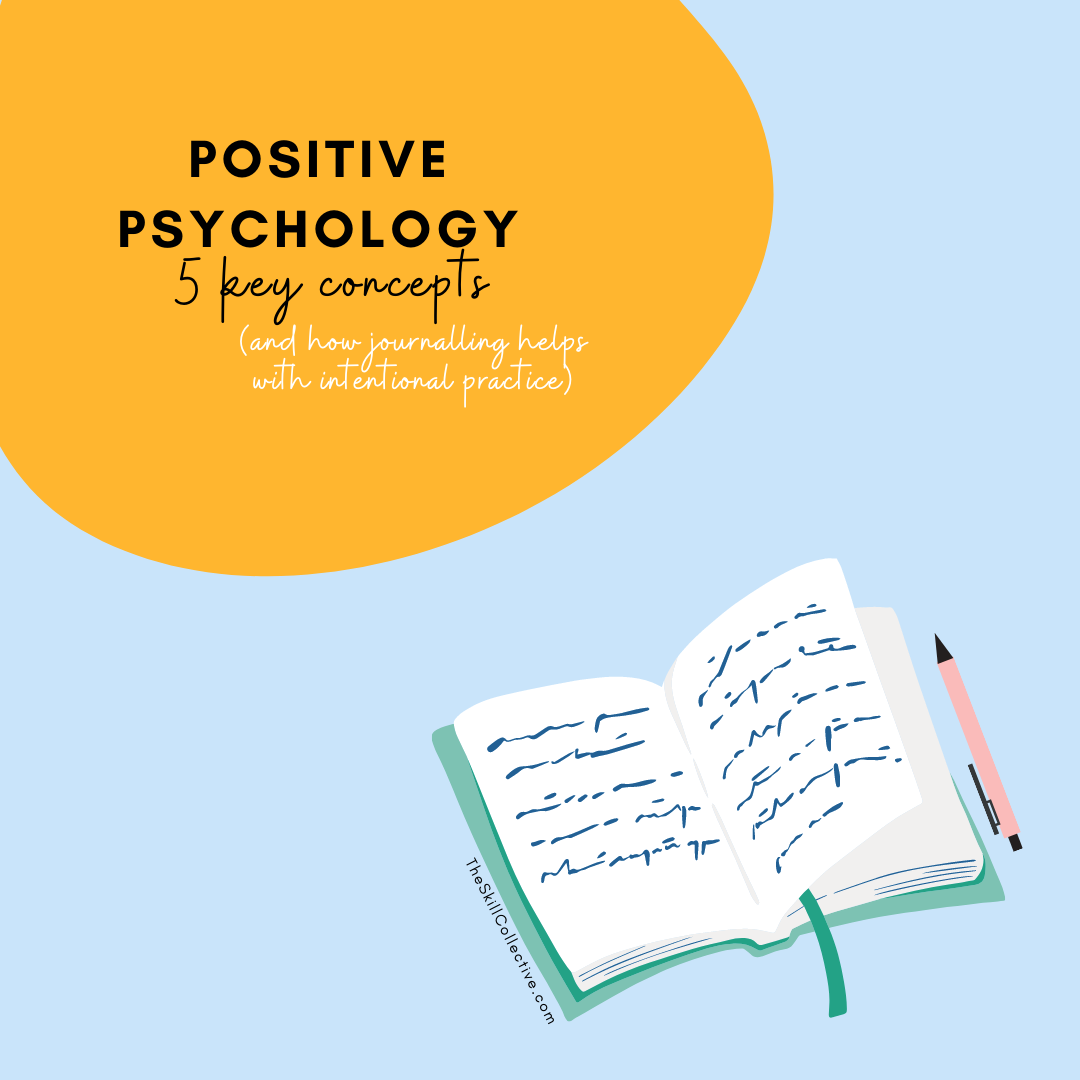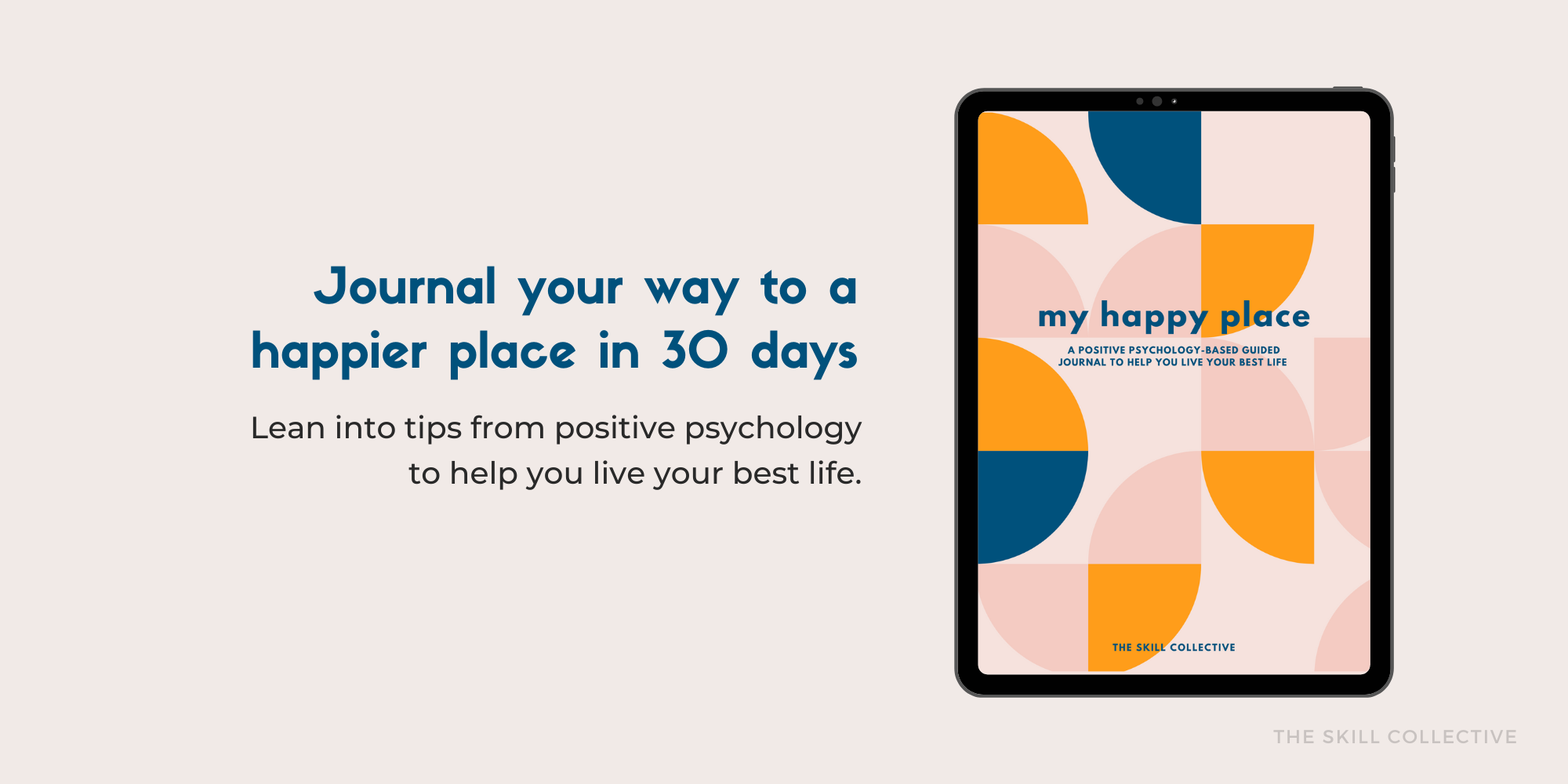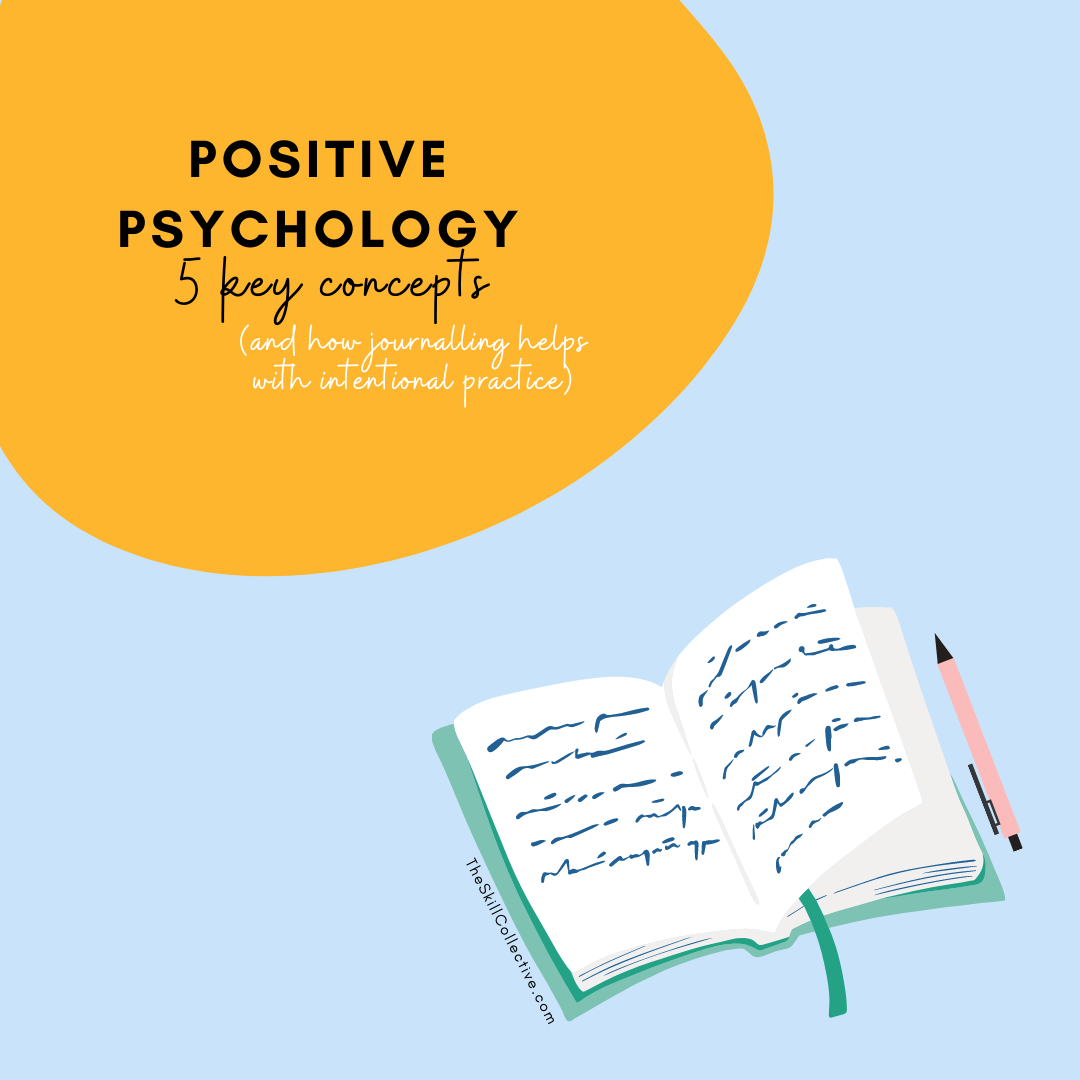Positive Psychology: 5 Key Concepts (and how journalling helps with intentional practice)
Positive Psychology: 5 Key Concepts (and how journalling helps with intentional practice)
By Giulia Villa, Registered Psychologist
“Curing the negatives does not produce the positives.” opined Martin Seligman, the father of positive psychology. With this, Seligman started a movement - and a refreshing detour from traditional psychology by turning our focus away from fixing negatives to maximising positives - to become more resilient. Specifically, those skills used to ‘fix’ our unhappiness differ from those that enable us to become better, more resilient versions of ourselves. Key concepts such as the three routes to happiness, PERMA/PERMAH, strength and values, grit, and gratitude, have found their places in our psychological toolkits. And if there’s anything that the Covid pandemic of the past 18 months has taught us, it’s that we can’t predict the challenges and setbacks that life may throw at us – resilience is key for us to thrive under difficult circumstances.
Positive psychology provides not only a framework, but also outlines behavioural interventions for a happier, more satisfying life. In this article, we highlight five key concepts of positive psychology, look at evidence regarding the effectiveness of psychological interventions, and examine how you can stay focused on the positive psychology track.
5 key concepts in positive psychology
1. The three types of happiness
The concept of happiness is perhaps viewed as synonymous with positive psychology, and the exemplar of positive emotions. Seligman proposed that there are three paths to achieving happiness. The twist is: they are not all equal. The first path, or level, is the Pleasant Life. We all have things that bring us happiness in the moment: that delicious slice of cake, sleeping in to avoid work, a few (maybe too many) drinks with friends. However whilst these bring us pleasure in the short term, the instant gratification we get from the Pleasant Life does not necessarily translate long-term happiness.
This brings us to the second type of happiness - the Good Life. We pursue happiness through this path by being engaged in what we do. We become engaged and live the Good Life when we frequently use our strengths and virtues in our day-to-day life. Engagement might look like being passionate about your work, building your personal relationships, or pursuing new hobbies.
The ultimate path to happiness is the Meaningful Life. We can lead a Meaningful Life when we use our strengths and character traits to serve a cause or purpose that is bigger than us. There is no singular cause that will be important to everyone, so infusing our life with meaning involves reflecting on what really matters to us.
To learn more about the 3 types of happiness head on over to this article.
2. PERMA/PERMAH
Another important concept in Positive Psychology is that of PERMA, which are the five building blocks of resilience and wellbeing identified by Seligman - Positive emotions, Engagement, Relationships, Meaning and Accomplishment. Let’s refresh these five components before we introduce the latest building block. In brief:
Positive emotions are important for resilience and wellbeing. In the moment, we can increase positive emotions by simply choosing to do things we enjoy. Practicing gratitude is a great way to feel more positively about the past and future.
We experience Engagement when we are fully immersed in an activity that requires our strengths, skills, and focus.
Intentionally investing in positive Relationships gives us purpose whilst building a protective tool against our own struggles.
We can all live a life filled with Meaning by working towards a purpose that is bigger than ourselves.
We gain a sense of Accomplishment by achieving goals that are important to us.
The latest research in positive psychology has expanded this model to add a sixth determinant of wellbeing: physical Health. We can break this down into three pillars:
Movement Recent research shows that those who exercise regularly are less likely to suffer from mental health disorders such as anxiety and depression.[1] Physical activity can reduce stress, boost mood and improve self-esteem.[2]
Healthy diet What we eat impacts how we feel not only physically but mentally. Alongside reducing the risk of chronic disease, a balanced diet can improve mood as well as cognitive function. A population study found that consumption of fruit and vegetables was the most consistent predictor of mental wellbeing.[3]
Sleep It’s challenging going about daily life under a cloud of tiredness, let alone try to improve ourselves. A lack of sleep can leave us feeling cranky and struggling to concentrate (hello brain fog). On the other hand, being well-rested is associated with positive emotions and having purpose – which we already know is key to achieving a Meaningful Life![4]
Learn more about the relationship between physical health and psychological wellbeing.
3. Strength and Virtues
So far, we have mentioned using your strengths to live an engaging and meaningful life, but it can be challenging to look inwards and know what these strengths are. Seligman and his colleague Peterson developed the Values in Action (VIA) Character Strengths Survey, comprising 24 character strengths categorized under six overarching virtues (Wisdom and knowledge, Courage, Humanity, Justice, Temperance, and Transcendence).[5]
In a similar vein to the Diagnostic and Statistical Manual of Mental Disorders (DSM), which is used for classification and diagnosis in traditional psychology, the VIA provides a framework to empirically assess and classify positive traits.
The VIA Strengths survey helps identify particular strengths, and by frequently applying and working on these strengths we are able to thrive and flourish.
Dr. Niemic from the VIA Institute on Character encourages us to be mindful and reflect on the role of our strengths in our lives: what strengths do we use when we are at our best? What about to overcome our struggles? We may notice that we have gravitated towards job opportunities, study paths, or hobbies which call on our strengths. Setting goals involving identifying strengths we wish to use more often, and integrating it into our daily routines. The more we practice tapping into our strengths, the more likely they are to become part of our routines and increase meaning and satisfaction in life. Head here for some great articles on how to harness strengths on a daily basis.
4. Grit
Grit is defined as passion for, and perseverance towards, long-term goals. It’s what keeps us going in the face of challenges. Research has found that grit is a greater predictor of success than other measures such as IQ and conscientiousness.[6] Not only do grittier people experience more success, they are also more resilient and find it easier to bounce back from adversity.
Unlike IQ, which remains relatively stable throughout adulthood, we can actually work to improve our own grit through intentional practice. Becoming ‘grittier’ requires a shift in mindset, involving examining those beliefs that hold us back, those beliefs that lead us to give up on things when we feel frustrated, or those that stop us from attempting a challenge out of fear.
Increasing grit involves crafting a balance between maintaining effort and interest. By varying mindset, seeing challenges and setbacks as learning opportunities, and incrementally stepping in the right direction, grit can be strengthened.
5. Gratitude
The practice of gratitude is not just the latest fad taking the wellness world by storm. Being grateful is a great way to amplify the effects of what is going ‘right’ in our life: a key tenet of positive psychology. In fact, the very act of expressing or receiving gratitude triggers the release of “happy” neurotransmitters in our brain: dopamine and serotonin.[7] These chemicals help us feel good and tap into those positive emotions, which we know are essential for wellbeing. The key to strengthening these neural pathways is to make gratitude a habit. To increase the likelihood of success, anchor gratitude practice to everyday tasks. Some examples of this are:
Jotting down a gratitude list whilst on the train to work.
Ending each day by naming three good things that happened that day, for example by journalling.
Writing a thank you message to a friend after spending some time with them.
How does positive psychology apply to real life?
Does positive psychology have the potential to trigger long term positive change? Let’s take a look at the evidence. For many, the workplace is an environment that conjures stress and anxiety. With the additional weight of the pandemic on our shoulders, it is no surprise that 63% of workers are experiencing decreased mental health due to workplace changes.[8]
To learn more about causes of burnout at work, check out our previous blog posts Early Career Burnout: Part 1 – Personal factors and Early Career Burnout: Part 2 – Workplace factors. Alongside addressing the personal and organisational factors mentioned in these articles, research suggests that positive psychology plays an important role on workplace performance and wellbeing. Positive psychology interventions in the workplace, such as gratitude diaries and capitalising on individual strengths, are linked to reduced stress and burnout amongst employees.[9]
Positive psychology is not just for adults. In schools, intervention programs based on positive psychology concepts have been successful at improving relationships and academic performance whilst reducing stress levels and symptoms of anxiety and depression in students.[10][11]
How journaling helps you practice Positive Psychology
So far, we have learnt about the key concepts in positive psychology and the effectiveness of positive psychology. But how can we maintain regular practice in order to reap the benefits of positive psychology in daily life? The answer: Intentional practice.
Intentional (or deliberate) practice aims to bring awareness and intent to all components of the to-be-implemented change. This means being mindful of the “what” and the “how”. Start by asking the following questions:
What is the desired outcome?
What behaviours need to be practised to achieve that outcome?
How will these behaviours bring about the desired outcome?
Resilience can be built through the intentional practice of evidence-based wellbeing interventions [12] in much the same way as deliberate practice helps with learning, skill acquisition, and expert performance in a wide range of areas (e.g. athletics, musical performance, etc.). Thus, for all of the 5 key concepts of positive psychology covered above, intentional practice can be applied in the following ways:
Positive emotions can be amplified through our intentional choice of activities that make us feel good.
A regular conscious practice of gratitude teaches us to intentionally focus on the positive sides of an experience.[13]
The intentional choice of activities in which we can express our strengths brings meaning and satisfaction to our lives.
One simple way to engage in intentional practice is via guided journalling, which is easily accessible to anyone. Journaling has been shown to improve psychological wellbeing and stress management.[14][15] It’s a highly portable activity that does not require significant planning, and the act of journalling gives you time to focus on enhancing your wellbeing.
Committing to journaling regularly, and in a guided manner to focus on the principles of positive psychology, can help you reach your goals and boost your wellbeing. It can be as simple as journalling about the positive aspects of your day, about a positive memory, or things that make you happy. Make a start today, and start journalling your way to improved wellbeing and resilience.
If a more structured approach is what will help you stick with the task, why not try guided journalling? Check out My Happy Place, a 30-day positive psychology-based journal with guided prompts.
If you’d like a tailored approach to building up your resilience and wellbeing reserves, why not contact us to make an appointment and get started?
REFERENCES
[1] Kandola, A. A., Osborn, D. P., Stubbs, B., Choi, K. W., & Hayes, J. F. (2020). Individual and combined associations between cardiorespiratory fitness and grip strength with common mental disorders: a prospective cohort study in the UK Biobank. BMC Medicine, 18(1), 1-11.
[2] Mikkelsen, K., Stojanovska, L., Polenakovic, M., Bosevski, M., & Apostolopoulos, V. (2017). Exercise and mental health. Maturitas, 106, 48-56.
[3] Stranges, S., Samaraweera, P. C., Taggart, F., Kandala, N. B., & Stewart-Brown, S. (2014). Major health related behaviors and mental wellbeing in the general population: The health survey for England. BMJ Open, 4(9).
[4] Steptoe, A., O'Donnell, K., Marmot, M., & Wardle, J. (2008). Positive affect, psychological well-being, and good sleep. Journal of Psychosomatic Research, 64(4), 409-415.
[5] Peterson, C., & Seligman, M.E.P. (2004). Character strengths and virtues: A handbook and classification. New York: Oxford University Press and Washington, DC: American Psychological Association.
[6] Duckworth, A. L., Peterson, C., Matthews, M. D., & Kelly, D. R. (2007). Grit: perseverance and passion for long-term goals. Journal of Personality and Social Psychology, 92(6), 1087.
[7] Zahn, R., Moll, J., Paiva, M., Garrido, G., Krueger, F., Huey, E. D., & Grafman, J. (2009). The neural basis of human social values: evidence from functional MRI. Cerebral Cortex, 19(2), 276-283.
[8] Relationships Australia. (2020). COVID-19 and its effects on relationships. https://relationships.org.au/what-we-do/research/online-survey/AprilSurveyReportRelationshipsAustralia3.pdf
[9] Meyers, M. C., van Woerkom, M., & Bakker, A. B. (2013). The added value of the positive: A literature review of positive psychology interventions in organizations. European Journal of Work and Organizational Psychology, 22(5), 618-632.
[10] Shoshani, A., & Steinmetz, S. (2014). Positive psychology at school: A school-based intervention to promote adolescents’ mental health and well-being. Journal of Happiness Studies, 15(6), 1289-1311.
[11] Waters, L. (2011). A review of school-based positive psychology interventions. The Educational and Developmental Psychologist, 28(2), 75-90.
[12] Kaye-Kauderer, H., Feingold, J.H., Feder, A., Southwick, S., & Charney, D. (2021). Resilience in the age of COVID-19. BJPsych Advances, 27, 166-178.
[13] Emmons, R. A., & Mishra, A. (2011). Why gratitude enhances well-being: What we know, what we need to know. In K. M. Sheldon, T. B. Kashdan, & M. F. Steger (Eds.), Designing Positive Psychology: Taking and Moving Forward (pp. 248-262). NY: Oxford University Press.
[14] Dimitroff, L.J., Sliwoski, L., O’Brien, S., & Nichols, L.W. (2017). Change your life through journaling – The benefits of journaling for registered nurses. Journal of Nursing Education and Practice, 7, 90-98.
[15] Pastore, C. (2020). Stress management in college students: why journaling is the most effective technique for this demographic. (Unpublished Honours thesis, State University of New York, New York). Retrieved from https://soar.suny.edu/handle/20.500.12648/1512






How can you counter the winter blues? Check out our tips on how to boost your wellbeing during the colder months.